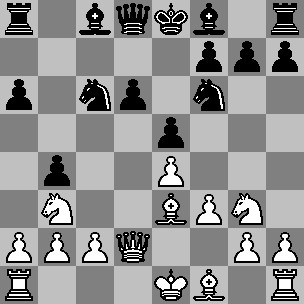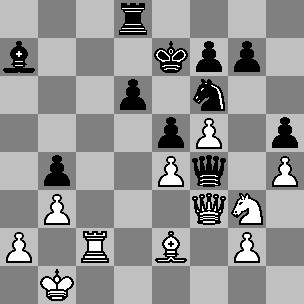11.05.2006
Sofia Round 1: Svidler-Topalov
Svidler (2743) - Topalov (2804)
Annotated by Konstantin Sakaev
1.e4 c5 2.Nf3 d6 3.d4 cxd4 4.Nxd4 Nf6 5.Nc3 a6 6.Be3 e6 Topalov rejects 6...Ng4, as he played against Svidler in San Luis.
7.f3 b5 8.Qd2 b4 9.Nce2 9.Na4 leads to a sharper game. Both knight moves occurred in Topalov games frequently, since 8...b4 is Topalov brand move.
9...e5 9...a5 is another possibility, as Topalov's helper Chearinov used to play.
10.Nb3 Nc6 11.Ng3
As it was shown in the game played last year, Black obtains a good game after a blocking 11.c4 Be7 12.Ng3 g6 13.Bd3 Nd7 14.Rd1 0-0 15.Qf2 a5, Kramnik-Topalov, Sofia, 2005. White seeks an advantage usually by 11.g4 h6, and only here - 12.Ng3. The downside of 11.g4 is that carrying out the f3-f4 advance becomes difficult, as the g4-pawn turns vulnerable.
11...Be6 12.0-0-0 Qc7 13.f4 h5! A typical maneuver is this kind of positions. The e4-pawn is weakened, and the g3-knight is placed very passively, doing only defensive job.
14.h4 Forced if White wants to keep the knight on g3. This is a serious achievement for Black! Not only the control over the g4-square is important - White's inability to undertake the g-pawn march is critical. 14.Bd3 is just ugly: 14...h4 (or 14...a5 at once, keeping the h5-h4 as a threat) 15.Ne2 a5 16.Kb1 a4, and White knights have to retreat to passive positions.
14...a5 15.f5 Bd7 Clearly inferior is 15...Bxb3? 16.cxb3, and White will make use of weakened light squares.
16.Kb1 Rb8 17.Be2 Na7! Black's last two moves are very strong. The rook starts X-raying the White's king on the b-file, and the knight was doing nothing on c6, so it had to be transferred somewhere. Natural and schematic 17...a4 18.Nc1 Na5 19.Bg5 leads to a better game for White.
Let me say a few words about other two games. Ponomariov has a small endgame advantage. Kamsky can survive, but he'll have to suffer. Anand seized the initiative, making three very strong and unobvious moves (12th-14th). He has better chances. Instead of 15...Rg8, he could play 15...g4 at once: 16.hxg4 hxg4 17.Nh2 c5, and White is under attack. However, after a safer 15...Rg8 Black is also better.
18.Bxa7!? A very interesting an unobvious decision. Black ideas are illustrated by the following sample line: 18.Bg5 a4 19.Nc1 Nb5 20.Bxb5 Bxb5 21.Nd3 b3 22.cxb3 axb3 23.a3 Qc2+ 24.Ka1 d5!, opening the game to his favor.
18...Qxa7 19.Qd3 Vacating the d2-square for the knight, from where it can go to с4.
19...Bb5 It is useful to drive the White's queen to an uncomfortable square f3 with a tempo.
20.Qf3 Positional queen sacrifice does not pose a real threat to Black: 20.Qxb5+ Rxb5 21.Bxb5+ Kd8. White has compensation, but it is only sufficient for the equality.
20...Bc6 Of course, exchange of the light-squared bishops is in White's favor. A complex position has arisen, the chances of the parties are approximately even.
21.Nd2 Qc5 22.Nb3 Qc6 23.Nd2 Be7 24.Nc4 Qc5 25.Ne3 a4 26.Bc4 Black chooses between 26...Bd8, vacating the e7-square for the King and transferring the bishop to b6, and 26...0-0, which seems to be the most correct.
26...Bd8 Now Svidler will probably double the rooks on the d-file.
27.b3? A loss of time. White had to utilize temporary weakening of the d6-pawn by 27.Rd3! Bb6 28.Rhd1, and Black cannot castle: 28...0-0 29.Nxh5! Nxh5 30.Qxh5 Bxe4 31.f6! with mating attack. Now Black obtains the a-file for a counterattack.
27...Bb6 28.Rd3 axb3 29.cxb3 Ra8 Now the game will likely continue 30.Rc1 Qa5 31.Rc2 Bc5 32.Nd5 Bxd5 33.Bxd5 Ra7 with approximate equality.
Anand achieved a better position against Bacrot. The endgame Ponomariov-Kamsky is most likely won for White. Grischuk found the right defensive plan against Ivanchuk in Dagomys - Alexander seized the e-file with the queen and then started improving his knight.
33...Rac8
34.Rxc8 White has slightly more space, thus it is better to keep pieces on board. In my opinion, stronger is 34.Bc4, maintaining the balance.
34...Rxc8 35.Bc4 Rh8 One could leave the h5-pawn unprotected by playing 35...Qc5. Taking the pawn is risky: 36.Nxh5 Qg1+ 37.Kc2 (Veselin probably overlooked that 37.Rd1 can be met by 37...Nxe4!) 37...Nxh5 (White holds in the variation 37...Ra8 38.Rd1 Rxa2+ 39.Kb1 Qxg2 40.Qxg2 Rxg2 41.Nxf6 gxf6 42.Rh1, and on 37...d5 there is 38.Rd1!) 38.Qxh5 Qxg2+ 39.Kd1 Rxc4 40.bxc4 Qxe4. Despite an extra exchange, White must seek salvation, as the Black's central pawns are very strong.
36.Rd2 Qc5 37.Qd1 Ba7 38.Rc2 Qe3 39.Bd3 Bc5 40.Qf3 Rd8
Well, Topalov's beloved endgame with opposite-colored bishops arose once again. Remember how he converted a seemingly microscopic advantage against Aronian. Let us see if the story repeats. The Black's pawn on b4 holds two White pawns, therefore Black has an edge. There are two plans of developing it - undertaking d6-d5 or g7-g5.
41.Be2 Qf4!? Also possible is 41...Qxf3 42.Bxf3 g6 43.fxg6 fxg6. The g3-knight has absolutely no future. If White brings it via f1-d2 to c4, Black can, for example, play Rg8 and advance g6-g5. After exchanging on g5 he will be threatening Rg5-g3 followed by h5-h4-h3, utilizing a very poor location of the f3-bishop.
42.Nxh5?! In my opinion, stronger is 42.Qxf4 exf4 43.Nxh5 Nxh5 44.Bxh5 Rh8 45.Bf3 Rxh4 46.Rd2 g5 47.fxg6 fxg6 48.Rd5, and White is very close to a draw.
42...Qxh4?! Black is also inaccurate. 42...Qxe4 43.Nxf6 Qxf3 44.Bxf3 Kxf6 45.g4 Rh8 46.Rh2 Bg1 47.Rh1 Bf2 48.Kc2 Bxh4 49.Kd3 Kg5 50.Kc4 Rb8 provides more winning chances.
43.Nxf6 gxf6
Ponomariov made a bad mistake on the 48th move, and Kamsky utilized it (48...h6!) to escape to a draw. Bacrot resigned to Anand.
44.g3 Qg5 45.Qg4? White could and should have played more actively: 45.Bc4! Rh8, and here it is important to make the king safe by 46.a4! bxa3 47.Ka2 - here he threatens to bring the queen to d5, his king is safe, and the b-pawn is a potential passer. White is not worse!
45...Rh8! Precisely! Now exchanging on g5 is highly dangerous - the Black's structure improves, and White cannot comfortably defend the g-pawn.
46.Qxg5 fxg5 The most natural now is 47.Bc4 - because of a tactical resource 47...Rh1 48.Rc1 Rh3 49.f6+! Black has to spend a tempo on blocking the f-pawn - 47...Kf6. Then White plays 48.Rg2 with good drawing chances.
47.Bg4! An interesting blockading idea!
47...Kf6 48.Rc1 Rh2 49.Rc2 Rh6 50.Rc1 Bf2 51.Rd1 Kg7 52.Rd3 Bd4 53.Kc2 Kf6 54.Rd2 Rh1 55.Rd1 Rh8 56.Kd3 Rc8 57.Ke2 Rc3 58.Rd3 Rc5 59.Bf3 Ke7 60.Rd2 A draw looks imminent, however, the game will go on util merciful arbiters interfere.
60...Rc3 61. Rd3 Rc8 62. Rd2 Rh8 63. Kf1 Rc8 64.Ke2 Rg8 65. Kf1 Rh8 66. Rc2 Bc5 67. Kg2 Kf6 68. Be2 Rh7 69. Rc1 Rh8 70. Rc2 Rh7 71. Rc1 Rh8 Game drawn
Resume
Bacrot-Anand
One careless opening move by Bacrot 12.e4?! was enough for Black to seize the initiative - I will highlight Anand's excellent reaction 12...Bf6!! followed by the g- and h-pawns advance. Etienne was not ready for such a turn and lost without a fight.
Ponomariov-Kamsky
The position that arose after the opening was unpleasant but defendable for Black, which had been confirmed in the recent game Ivanchuk-Grischuk. Gata Kamsky probably was unaware of it, as he selected a wrong plan linked with protecting the queenside pawns with the king (25...Kf7? instead of 25...Qe7). The resulting endgame "bishop vs. knight" was very likely won for White, but Ruslan overlooked an excellent defensive resource 48...h6!, which allowed Black saving half a point.
Svidler-Topalov
The most complex and rich game, which was full of brilliant ideas (I'll mention only a couple of excellent moves - 13...h5! and 17...Na7! by Topalov, and 18.Bxa7! by Svidler) and mistakes, as it often happens in such a complex opening as the Najdorf. One of those mistakes, 27.b3 (instead of correct 27.Rd3 followed by 28.Rhd1) created problems for White. Svidler overcame them with stubborn defense that culminated in a beautiful and unexcpected resource: 47.Bg4! The game came to a peaceful conclusion.





